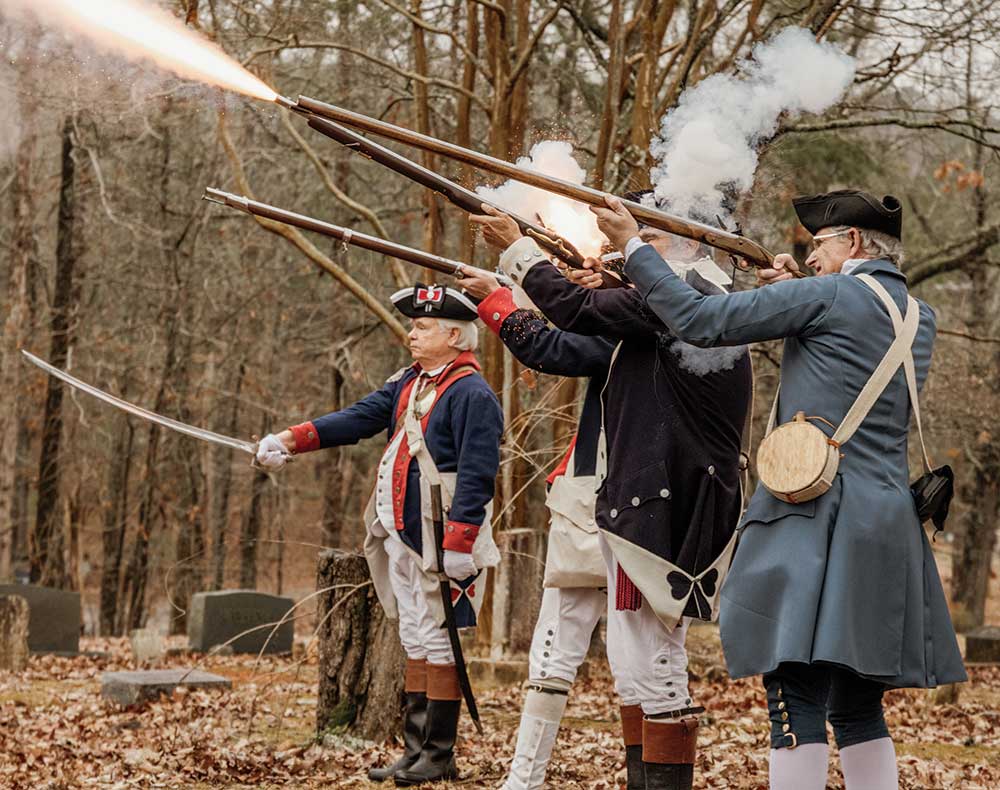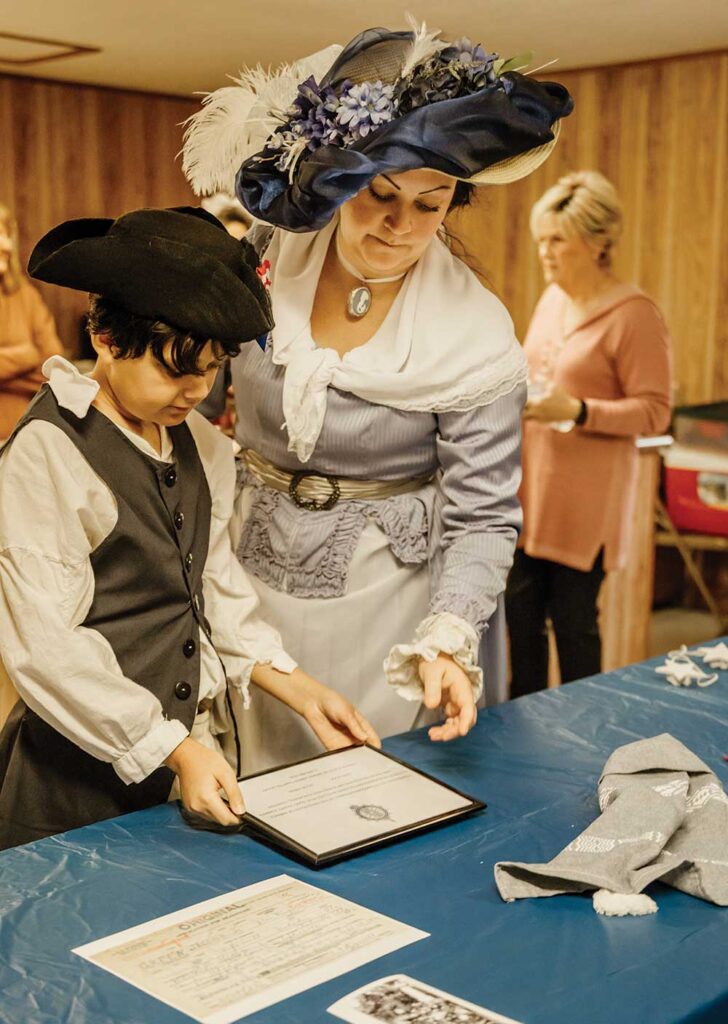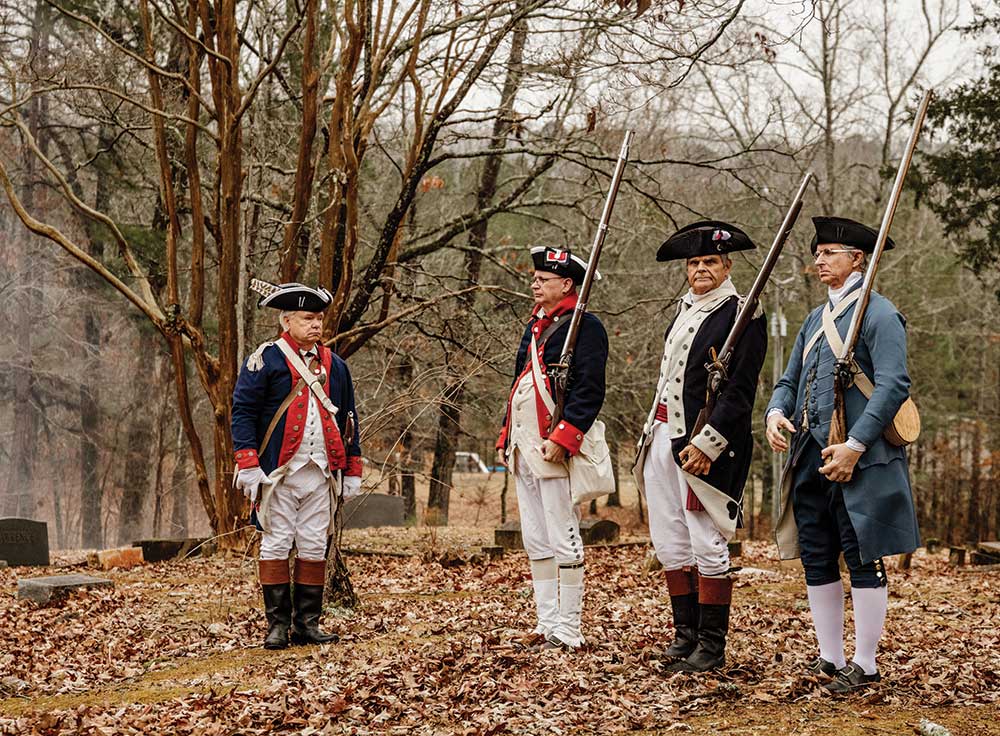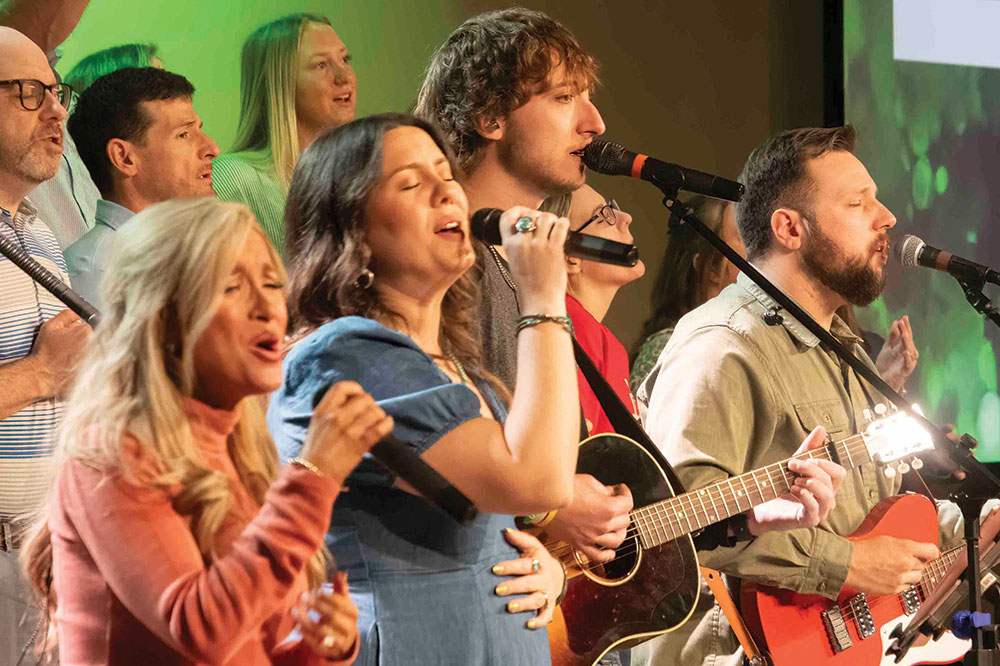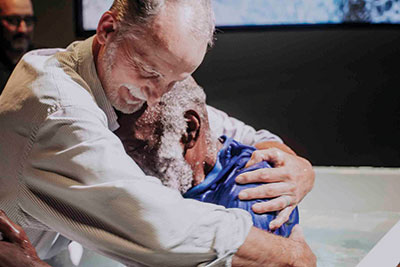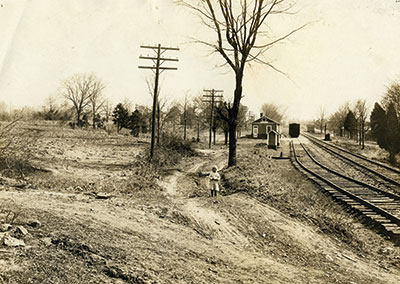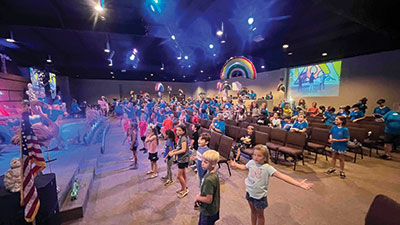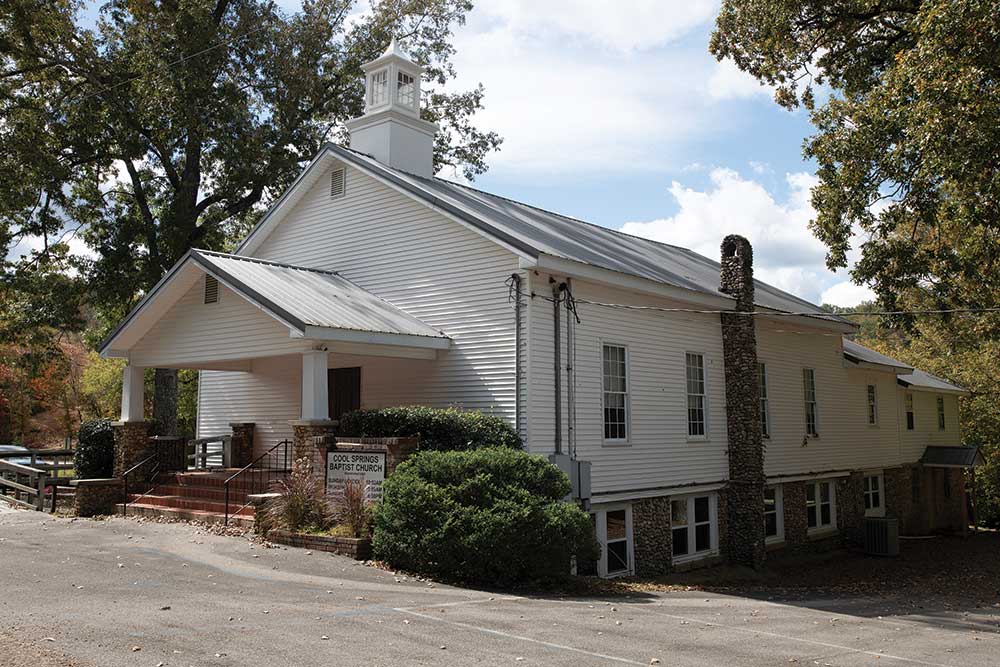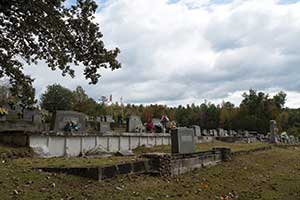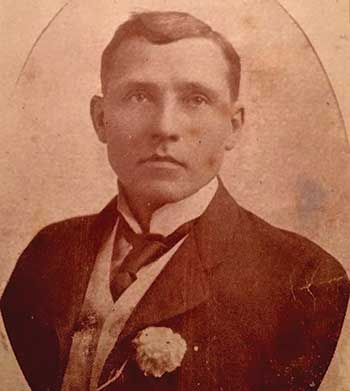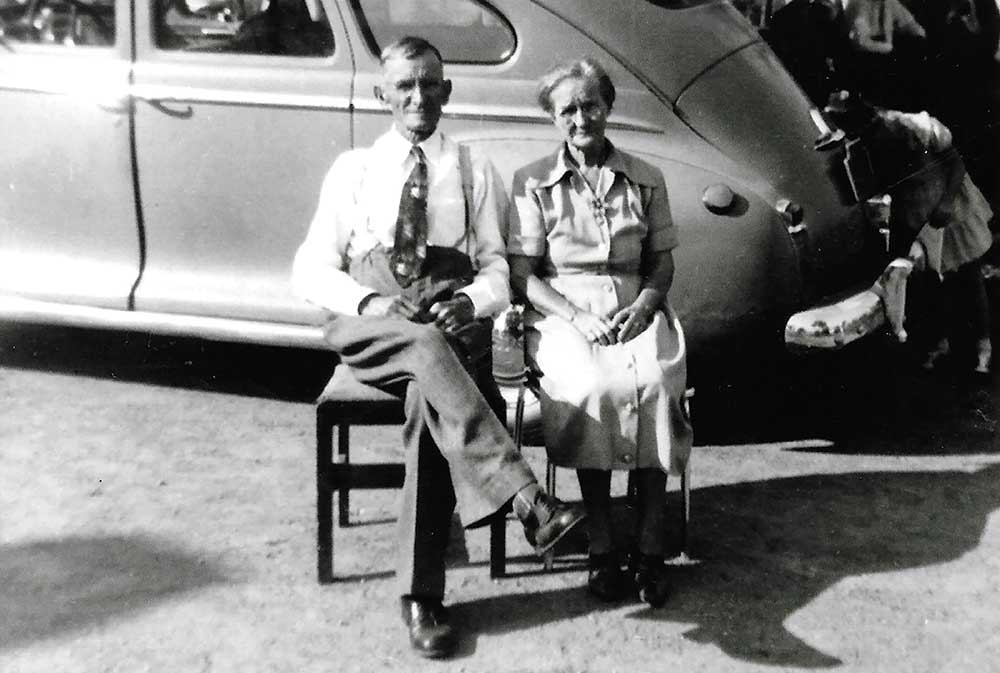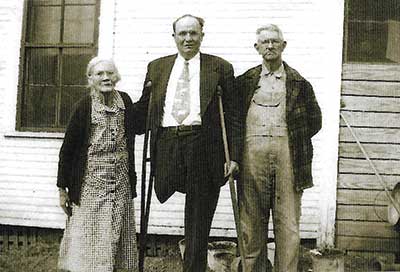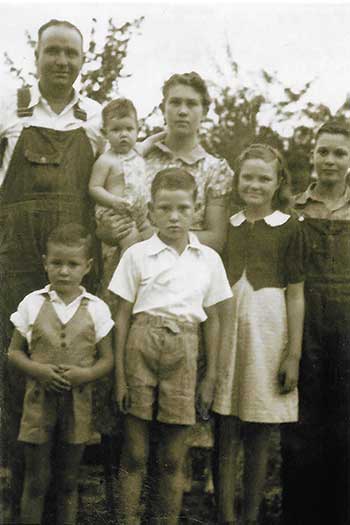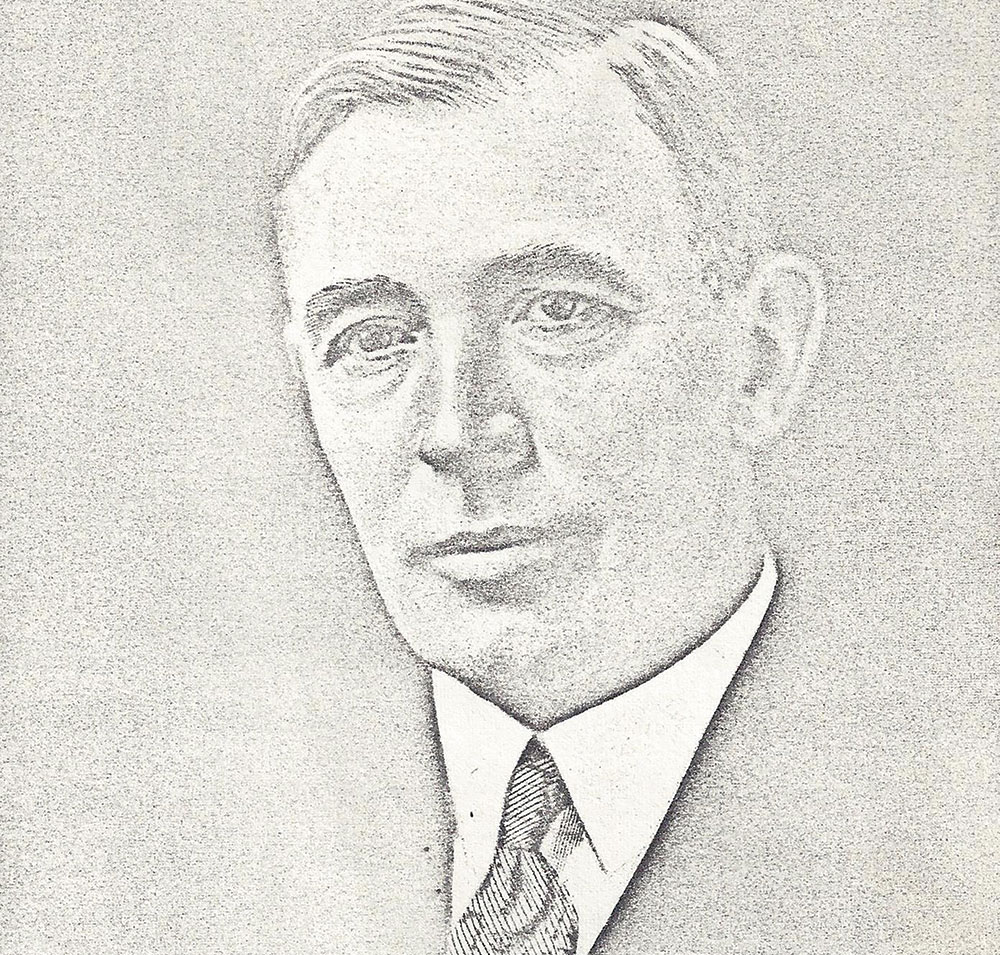DAR places war memorial marker
Story by Joe Whitten
Photos by Mackenzie Free
All through the night, clouds took turns sobbing over Hopewell Cemetery’s tombstones, cedar trees, and leafless dogwoods, and dawn broke dank and damp. In stark contrast in the older section, the recently cleaned tombstones of Jacob Green, Robert Hood, Sarah Hood and John Hood stood white against the gloom, and a new gray granite marker at Jacob Green’s grave glistened from the rain.
The marker drew members of the Broken Arrow Chapter of the Daughters of the American Revolution (DAR) to New Hopewell Baptist Church Fellowship Hall on a Saturday morning in January to honor the tribute.
Event preparation began in 2024 when Washington’s DAR National Headquarters announced available grants of $500 to local chapters to celebrate the Semiquincentennial (250th) celebration of the United States. The grant guidelines stipulated that not only must the Revolutionary War veteran’s grave be in the cemetery, but that some of his descendants must also be entombed there, for the marker is in memory of the veteran’s descendants in the same cemetery.
Broken Arrow member Ann Coupland suggested Jacob Green because she knew he was buried at Hopewell Cemetery, and that the Gadsden DAR chapter had placed a tombstone at his grave in 1937. Further, Ann also knew that his name and John Hood’s were not on the Revolutionary War Veterans marker behind the Inzer House.
Choosing John Hood was almost serendipitous. One day, Mindy Manners, Regent of Broken Arrow Chapter, was walking in Hopewell Cemetery near Jacob Green’s resting place. Just a few graves away from Green’s, she saw the tombstone for Robert Hood, “Born April 1793, Died April 12, 1858.” The 1793 date caused her to think Robert had Revolutionary War connections. Back home, she researched Robert’s ancestry and found his father, John Hood, and his service record.
Buried next to Robert is his wife, Sarah (1792-1855); and next to her is their son, Rev. John Hood (1820-1851); however, there’s no stone for John Hood there. Where is he buried?
John Hood lies in an unmarked grave which some writers and researchers have speculated is in the Ashville Cemetery. However, Hopewell Cemetery is more likely for three reasons. First, his son, daughter-in-law, and grandson are interred there. Second, Daniel Hood in his paper titled, “The Noah Hood Family,” states, “The Hood family has been associated with the Hopewell Baptist Church since its construction (organization) in July 1830. Five Hoods were charter members.
Indeed, in the Hopewell Cemetery, Hoods account for some of the earliest residents.” Third, from 19th century obituaries that the community of Hood’s existed, for it is recorded as place of residence, as in Roland Hood’s obituary, Aug. 29, 1889, in The Southern Aegis. “Died on Aug. 25, 1889, at his residence near Hood’s this county, Roland Hood, age 71 years. He had lived in the neighborhood where he breathed his last all his life, except for two years.” So, there exists a strong connection with the Hood family, the church, the cemetery and the community.
Broken Arrow members were busy in the Fellowship Hall, where some decorated tables with patriotic colors, miniature stars and stripes, and flower arrangements, while others set out refreshments. One of those members is especially noteworthy, Emma Scott Milam. She is the only surviving charter member of the Broken Arrow Chapter which was established a little over 70 years ago. As soon as she turned 18, her aunt had her sign the papers to come in as a charter member.
Members of the Green and Hood families and other visitors gradually filled the room as the Fellowship Hall program hour arrived.
Following the opening prayer by Chaplain Emma Milam, the Alabama Society of the Sons of American Revolution Color Guard, in 18th Century military attire, brought the flag to the front for the Pledge of Allegiance, then they placed the flag in its holder.
Next, the assembly read in unison The American’s Creed. Mindy introduced special guests: Rev. Johnny Wilson, host and pastor of New Hopewell; Joe Barker, commander of the SAR Color Guard; Kristi Averette, The Flag of the United States American State Committee Chair, Alabama Society Daughters of the American Revolution; and attending journalist.
Regent Manners related interesting facts about Alabama and St. Clair County Revolutionary War veterans, many of whom moved their families here, and records indicate that more than 700 are buried in Alabama.
Many of the grave markers have been weathered away or destroyed by the passing years, and it is believed that the last veteran to die was William Speer, who lived to be 101. He died in 1859 and is buried in Bivens Chapel Cemetery in Jefferson County.
After the Regent’s remarks, members of Jacob Green’s family were recognized and 8th generation Josiah Jacob Evans, eight years old, read Jacob’s brief history written by his Aunt Beth Evans-Smith.
Jacob Green’s history resonates with America’s and St. Clair County’s early history. He was born in North Carolina in 1767 and was only nine years old when the Declaration of Independence was signed July 4, 1776. Official records show that an 18-year-old Private Jacob Green was “…paid with interest, on 21 June 1785 for duty done in the Militia in 1782.”
In 1787, 20-year-old Jacob married Frances “Fannie” Baker in North Carolina. Over the years, 10 children blessed their home.
Family records state that Jacob also fought in the War of 1812, and that at the end of the war, perhaps around 1815, Jacob and other men journeyed to Alabama to explore land along the Coosa River. Then in 1818, Jacob and Fannie, now living in South Carolina, resigned their membership in the Buffalo Baptist Church and began the tedious trek to Alabama.
Although the date they arrived in St. Clair County with their six younger children is unclear, Green family researchers believe the family arrived here between 1818 and 1820. The 1820 census records show that Jacob Green owned land in St. Clair County and that he formerly resided in South Carolina.
Jacob built the family’s first home on today’s Greensport Road, a little south of Canoe Creek where U.S. 411 crosses into Etowah County. This spacious home also served for many years as a stop on the Montevallo stagecoach route.
Mary Ellen Sparks wrote in an article, Stagecoach Stop, published Aug. 7, 2019, in the St. Clair Times, “Springer and Pollard Stagecoach Lines ran between Pulaski, Tenn., and Montevallo for a total of 133 miles. The mail was delivered semi-weekly at $25 per trip. There were 13 mail stops along this route. It traveled through six Alabama counties. The stagecoach would leave Ashville at 4 a.m. and arrive in Montevallo the next day at 9 a.m. It was a 29-hour ride amidst wild animals, inclement weather and probably hostile Indians and Outlaws.”
By the 1830s, there was a need for a ferryboat on the Coosa River to connect St. Clair County with Calhoun County. When the federal government approached Jacob about operating the ferry, he accepted the challenge. Therefore, he left the Stagecoach house and built another spacious house by the river at what came to be called Greensport.
Jacob successfully operated the ferry for some years as age crept up on him. The 1840 census records list a man about Jacob’s age living with Jacob’s daughter, Nannie Green Dill, and her husband. Jacob’s wife, Fannie, must have predeceased him. His name does not appear in the 1850 census.
When Alabama Power constructed Neeley Henry` Dam and Lake, the house was torn down and lake waters soon flooded over where it once stood. Today on Jacob Green’s Coosa River land is the Greensport RV Park and Campground, and the Greensport Marina, a beautiful and peaceful St. Clair County recreational center on Lake Neely Henry, operated by Jacob’s descendants.
John Hood
When the John Hood family was recognized, Anthony Hood read John’s brief history.
His birth date remains a mystery, but researchers think it occurred in the area of 1745 to 1750. He was the eldest son of Tunis and Elizabeth Harrison Hood of Frederick County, Virginia, now a part of Berkeley County, West Verginia.
The Hood families seemed restless, for in 1772 John was in Burk County, North Carolina, then c1775 they moved to Mecklenburg County, North Carolina. Tunis Hood, John’s father, and other members of the family relocated to Mecklenburg County around 1775, as well.
John’s American Revolution service was with the North Carolina Militia, Salisbury district, made up from Mecklenburg and other counties. Records also show that Tunis Hood gave material aid to Revolutionary forces. John’s brothers, Tunis Jr., Solomon and Robert, served with Mecklenburg County forces as well.
After the war, John moved his family to Greene County, Georgia, around 1792 and stayed there about 24 years before migrating to Alabama c1816. Hood descendants believe John died in 1835 and Sarah in 1837.
John married Sarah “Sallie” Austin in 1777, and they were parents to eight children: Austin, James, Amos, Isaac, Robert, William, Osborn and daughter Lovina. Robert is buried at Hopewell Cemetery.
There is a possible John Hood and Abraham Lincon connection as recorded by Anthony Hood. “John Hood’s mother was Elizabeth Harrison, daughter of John Harrison and granddaughter of Isaiah and Elizabeth Wright Harrison. Elizabeth Wright Harrison died soon after the birth of their fifth child. Isaiah married second to Abigail Smith, and they had three children, with Abigail Harrison being [their] daughter who married Alexander Herring. Abigail Harrison Herring is strongly speculated to be the great-grandmother of Abraham Lincoln, making John Hood a distant cousin to Abraham Lincoln.”
Of special note on other family ties, Elvis Presley is a direct descendant of John Hood. Elvis’s grandmother, Minnie Mae Hood Presley, is John Hood’s great-great-granddaughter. At the Tunis Hood plantation site at Hood’s Crossroads in Mint Hill, North Carolina, there is a plaque commemorating the Elvis connection. Minnie Mae Hood Presley is buried at Graceland.
When the biographical sketches ended, the DAR ladies served finger foods, hot chocolate and coffee, after which the group reassembled at Jacob Green’s gravesite for the dedication of the memorial:
“COMMEMORATING THE SEMIQUINCENTENNIAL OF / THE UNITED STATES OF AMERICA / WE HONOR THE REVOLUTIONARY SOLDIERS WHO LIVED IN / ST. CLAIR COUNTY, ALABAMA / AND WHOSE DESCENDANTS ARE BURIED HERE / IN HOPEWELL CEMETERY / JOHN HOOD / JACOB GREEN / MARKER PLACED BY BROKEN ARROW CHAPTER NSDAR / 18 JANUARY 2025.”
Regent Manners dedicatory remarks were thought provoking. “It is fitting that we praise especially here today no famous men. We come instead to honor those who fought and died without recognition.
“Their names and deeds are known only to those who were their comrades, families, and of course, known to God… These ordinary soldiers best symbolize such acts of quiet courage by ordinary people whose reward is that their nation and their freedoms remain secure for future generations.”
She ended her remarks with these words from General George Washington, who knew war and its conquests of exposure, wounds and death: “To be prepared for war is one of the most effectual means of preserving peace.”
Chaplain Milam prayed the dedicatory prayer, followed by the SAR Color Guard firing three rounds with their muskets, much to the delight of the children in attendance.
As the musket smoke wafted away, Rev. Johnny Wilson read the lyrics of Taps, of which the poignant last stanza was a fitting end to the ceremony.
All is well… Fare thee well
Day has gone, night is on.
Thanks and praise, for our days,
‘Neath the sun, ‘Neath the stars, ‘Neath the sky,
As we go, this we know, God is nigh.
As folk began drifting back to the Fellowship Hall or the parking lot, clouds drifted apart enough to reveal bits of blue sky above the gray, and feeble sunrays touched the tops of tombstones old and new.
And there in the silent quietness, one might think he heard from far away, the notes of Taps, echoing through the years, “All is well. All is well.”











